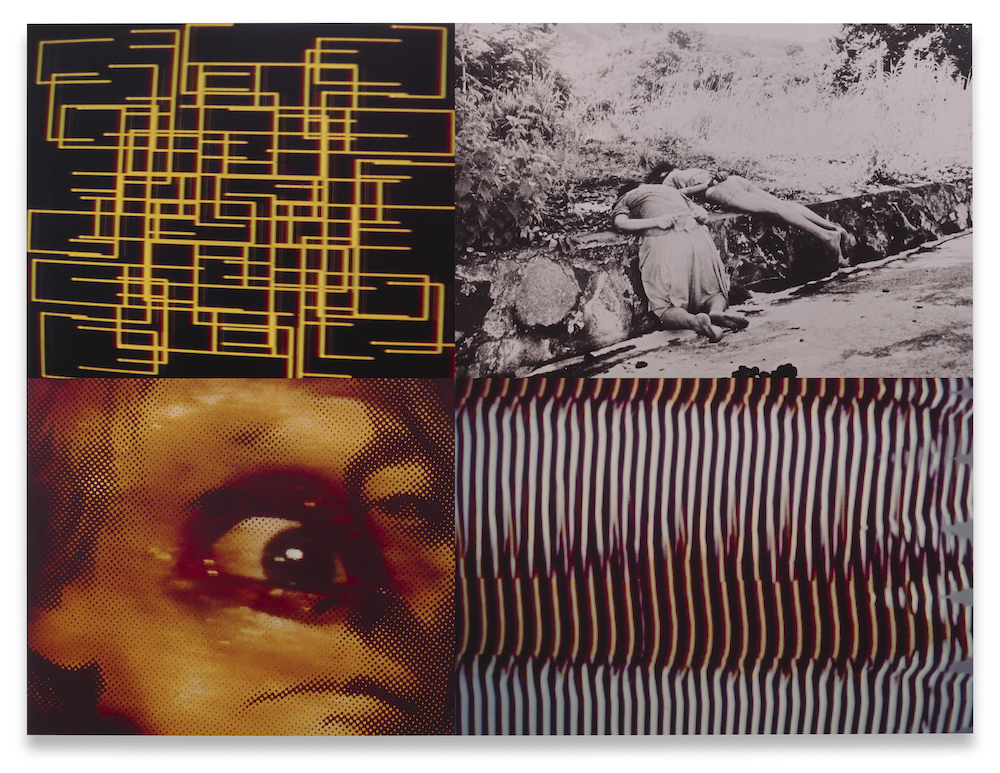In 1987, Cindy Sherman interviewed Gretchen Bender for BOMB Magazine, discussing the influence of her work on mass media. Bender denied the relationship between the two and instead described media as a ‘cannibalistic river without a conscience,’ invoking the image of a current that swallows, digests, and regurgitates life into a seamless stream of information. At Sprüth Magers, the solo exhibition “The Perversion of the Visual” digs into Bender’s preoccupation with the United States military intervention in the Salvadoran Civil War, referring to the violently graphic imagery documented by American photographers of the armed conflict.
Titled after the Hollywood film, the four-dye sublimation print Gremlins (1984) places side-by-side images within a single frame: two stills of computer-generated graphics, an eyeball superimposed on a woman’s face, and a black-and-white photograph by the American photojournalist John Hoagland. The photograph portrays two girls lying lifelessly amid overgrown weeds near the highway to Comalapa Airport in El Salvador. Hoagland died by the strike of a bullet during a crossfire between the Salvadoran army and leftist guerrillas the same year Bender created Gremlins. His remembrance, along with that of the unidentified victims, lives through the inclusion of his snapshot like a wormhole that merges past with present. Four decades after the war, Gremlins provokes the same visceral jolt that images of war-torn landscapes once elicited in Bender.
Another work on view is Dumping Core, an eight-channel video installation whose title refers to an early term for a computer crash and the recording of its memory for later analysis. The installation projects what can be described as a screen capture of 1980s television culture. Footage of machine guns and flying helicopters are interwoven with corporate logos (AT&T, CBS, and NBC) and digital animations—all set to a thundering soundtrack of electronic music composed in collaboration with Stuart Argabright, Michael Diekmann, and Shin Shimokawa. Hypnotic and rhythmic, the installation’s sensory overload limits the ability to think beyond the immediate visuals, reflecting the numbing effect of media that Bender critically examined and sought to manipulate.
Bender drew inspiration from the book El Salvador: Work of Thirty Photographers, a compilation of war photographs by Susan Meiselas. The book is on display in a separate room from the installation, along with a collection of print materials illustrating Bender’s involvement in the nationwide activist project “Artist’s Call Against US Intervention in Central America.” For example, an orange poster designed by Claes Oldenburg lists the 1,087 names of participating artists, including Andy Warhol and Sol LeWitt. Other materials include Bender’s manifesto titled The Perversion of the Visual, the 1983 Winter issue of Upfront: A Publication of Political Art Documentation / Distribution, and a xeroxed flyer by Artist’s Call soliciting public participation.
Though Bender is primarily recognized for her mastery of video technology, “The Perversion of the Visual” reveals the depth of her engagement in political commentary. Her tribute to photojournalists portrays death as an interruption to the continuity of life and a disruption to the mechanical routine of American society—to clock out work, return home, and sit on the sofa to watch that day’s evening show. The casualties of the Salvadoran Civil War diverted the stream that Bender once described to Sherman, suggesting that perhaps dying had some significance after all for this uprising and others to come.


